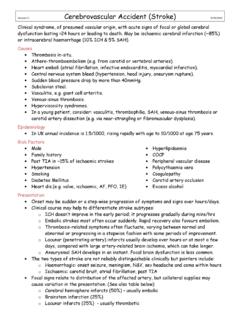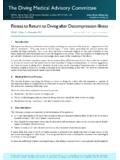Transcription of New Zealand Datasheet 1 PRODUCT NAME 2 …
1 New Zealand Datasheet 1 PRODUCT NAME. FIBROVEIN , , and intravenous injection 2 QUALITATIVE AND QUANTITATIVE COMPOSITION. Sodium Tetradecyl Sulphate , , and intravenous injection Contains benzyl alcohol 20mg/ml. For a full list of excipients, see section 3 PHARMACEUTICAL FORM. Solution for injection. Clear, colourless, sterile solution. pH Osmolarity 247 273 mOsm/kg. 4 CLINICAL PARTICULARS. Therapeutic indications Fibrovein 3% and 1%: For the treatment of varicose veins of the leg by injection sclerotherapy. Fibrovein : For the treatment of varicose veins and venous flares of the leg by injection sclerotherapy. Fibrovein : For the treatment of minor venules and spider veins (venous flares) by injection sclerotherapy. Dose and method of administration Route of Administration For intravenous administration into the lumen of an isolated segment of emptied vein followed by immediate continuous compression.
2 Recommended doses and dosage schedules: Adults Fibrovein : to of Fibrovein injected intravenously at each of 4 sites (maximum 4ml). Fibrovein : to of Fibrovein injected intravenously into the lumen of an isolated segment of emptied superficial vein, followed by immediate compression. A. maximum of 10 sites (10ml total) may be injected during one treatment session. Fibrovein : to of Fibrovein injected intravenously into the lumen of an isolated segment of emptied superficial vein, followed by immediate compression. A. maximum of 10 sites (10ml total) may be injected during one treatment session. Fibrovein : to of Fibrovein injected intravenously at each of 10 sites (maximum 10ml). The smallest of needles (30 gauge) should be used to perform the injection, which should be made slowly so that the blood content of these veins is expelled.
3 In the treatment of spider veins an air block technique may be used. Children All strengths: not recommended in children The Elderly As for adults. Contraindications Hypersensitivity to sodium tetradecyl sulphate or to any component of the preparation and allergic conditions. Patients unable to walk due to any cause, bedridden patients. Patients with a high risk of thrombosis patients with a congenital predisposition to blood clots or with multiple risk factors such as hormonal contraceptives or hormone replacement therapy, significant obesity, smoking or extended periods of immobility Recent acute superficial thrombophlebitis, deep vein thrombosis or pulmonary embolism Recent surgery Local or systemic infection. Varicosities caused by pelvic or abdominal tumours unless the tumour has been removed Uncontrolled systemic disease such as diabetes mellitus mellitus, toxic hyperthyroidism, tuberculosis, asthma, neoplasm, sepsis, blood dyscrasias and acute respiratory or skin diseases Evolutive cancer Significant valvular incompetence of the deep veins Occlusive arterial disease Huge superficial veins with wide open communications to deeper veins Phlebitis migrans Acute cellulitis Acute infections Special warnings and precautions for use Fibrovein should only be administered by practitioners experienced in venous anatomy and the diagnosis and treatment of conditions affecting the venous system and familiar with proper injection technique.
4 Thorough pre-injection assessment for valvular competence and deep vein patency must be carried out. Extreme care in needle placement and slow injection of the minimal effective volume at each injection site are essential for safe and efficient use. Before treatment, the healthcare professional should investigate patient's risk factors and inform them about the risks of the technique. As a reminder, sclerotherapy is contra- indicated in patients with high risk of thromboembolic events but should also be avoided in most situations at lower risk. Sclerotherapy is notably not recommended in patients with a history of thromboembolic events Nevertheless, if sclerotherapy is judged necessary, preventive anticoagulation can be initiated. Due to the risk of circulation of PRODUCT , bubbles or particulates in the right heart, the presence of a PFO may enhance the occurrence of serious arterial adverse events.
5 In patients with history of migraine with aura, serious cerebrovascular events or pulmonary hypertension, it is recommended to search for PFO before sclerotherapy. In patients with asymptomatic but known PFO, it is recommended to use smaller volumes and avoid Valsalva manoeuvre in the minutes after injection. Use smaller volumes in patients with history of migraine. Severe adverse local effects, including tissue necrosis, may occur following extravasation;. therefore, extreme care in intravenous needle placement and using the minimal effective volume at each injection site are important. Sclerosants must never be injected into an artery as this can cause extended tissue necrosis and may result in loss of the extremity. Injection under duplex ultrasound is recommended in order to avoid extravasations and arterial injection.
6 Healthcare professional should monitor the patient during and after the administration of Fibrovein. Symptoms of hypersensitivity (redness, pruritis, cough) or neurological symptoms (scotoma, amaurosis, migraine with aura, paraesthesia, focal deficit) may happen Special care should be taken in patients with laboured breathing (bronchial asthma) or a strong predisposition to allergies (see Dosage and Administration). Emergency resuscitation equipment should be immediately available. Allergic reactions, including anaphylaxis have been reported. The possibility of an anaphylactic reaction should be kept in mind, and the physician should be prepared to treat it appropriately. Because of the danger of thrombosis extension into the deep venous system, thorough pre- injection evaluation for valvular competency should be carried out and slow injections with a small amount (not over 2 ml) of the preparation should be injected into the varicosity.
7 Deep venous patency must be determined by non-invasive testing such as duplex ultrasound. Venous sclerotherapy should not be undertaken if tests such as Trendelenberg and Perthes, and angiography show significant valvular or deep venous incompetence. Healthcare professionals should see the patient again after 1 month for a control of treatment efficacy and safety, by clinical and ultrasound evaluation. The development of deep vein thrombosis and pulmonary embolism have been reported following sclerotherapy treatment of superficial varicosities. Patients should have post- treatment follow-up of sufficient duration to assess for the development of deep vein thrombosis. Embolism may occur as long as four weeks after injection of sodium tetradecyl sulphate.
8 Adequate post-treatment compression may decrease the incidence of deep vein thrombosis. Extreme caution in use is required in patients with arterial disease such as severe peripheral atherosclerosis or thromboangitis obliterans (Buerger's Disease). Special care is required when injecting above and posterior to the medical malleolus where the posterior tibial artery may be at risk. Pigmentation may be more likely to result if blood is extravasated at the injection site (particularly when treating smaller surface veins) and compression is not used. Interaction with other medicines and other forms of interaction No interaction studies have been performed. Fertility, pregnancy and lactation Fertility It is not known whether sodium tetradecyl sulfate affects fertility.
9 Use in Pregnancy Safety for use in pregnancy has not been established. There are no or limited amount of data from the use of sodium tetradecyl sulphate in pregnant women. Animal studies are insufficient with respect to reproductive toxicity. Treatment should be postponed until after childbirth. Fibrovein should be used only when clearly needed for symptomatic relief and when the potential benefits outweigh the potential hazards to the foetus. Use in Lactation It is not known whether sodium tetradecyl sulphate is excreted in human milk. Caution should be exercised when used in nursing mothers. Effects on ability to drive and use machines A bandage and/or compression stockings may be added after treatment. This could affect the ability to drive. Undesirable effects The most commonly reported side effects are pain on injection urticaria, superficial thrombophlebitis and temporary skin pigmentation after treatment.
10 Very rarely a permanent discoloration may remain along the path of the sclerosed vein segment. Ulceration may occur following extravasation of the drug. It is important to use the lowest strength that will sclerose the vein as many of the common side effects are caused by using a concentration that is too high. Intra-arterial injection although very rare has been reported resulting in significant tissue necrosis including loss of the extremity. The most serious side effects are anaphylactic shock and pulmonary embolism and deaths have been reported in patients receiving sodium tetradecyl sulphate. Adverse events are listed below by system organ class and estimated frequency from published clinical data. Frequencies are defined using the following convention: Very common 1/10.












